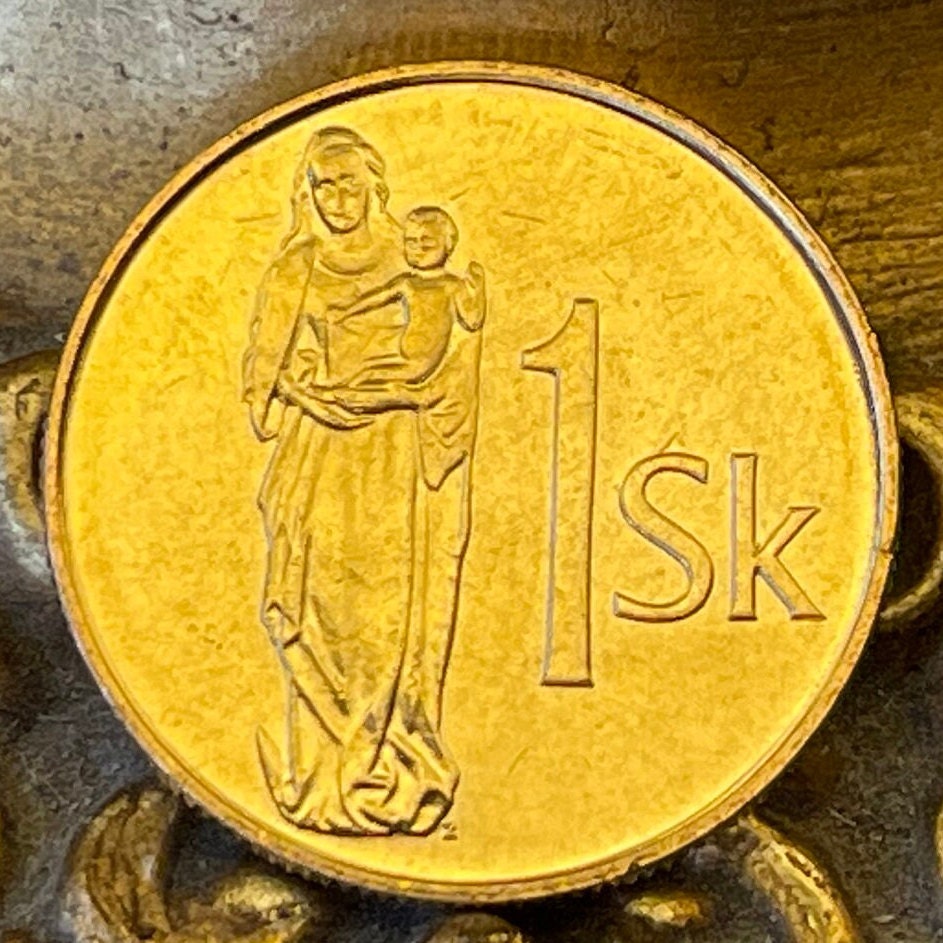elemintalshop
Madonna and Child 1 Koruna Slovak Republic Authentic Coin Money for Jewelry and Craft Making (Gothic Wooden Statue) Slovak National Gallery
Madonna and Child 1 Koruna Slovak Republic Authentic Coin Money for Jewelry and Craft Making (Gothic Wooden Statue) Slovak National Gallery
Couldn't load pickup availability
Madonna and Child 1 Koruna Slovak Republic Authentic Coin Money for Jewelry and Craft Making (Gothic Wooden Statue) (Slovak National Gallery) (Double Cross)
Reverse: Gothic wooden sculpture of the Madonna and Child.
Lettering: 1Sk
Translation: 1 Slovak Koruna
Obverse: The Slovak shield above the country name
Lettering: SLOVENSKÁ REPUBLIKA
Translation: Slovak Republic
Features
Issuer Slovakia
Period Republic (1993-date)
Type Standard circulation coin
Years 1993-2008
Value 1 Koruna (1 SKK)
Currency Koruna (1993-2008)
Composition Bronze plated steel
Weight 3.85 g
Diameter 21 mm
Thickness 1.7 mm
Shape Round
Orientation Medal alignment ↑↑
Demonetized 01-17-2009
Number N# 2486
References KM# 12, Schön# 15
The inspiration for the reverse of this coin is a 75-cm high wooden sculpture of the Madonna and Child standing on a crescent made around 1490. It was originally standing in Kremnica and today can be seen in the Slovak National Gallery (Slovenská národná galéria) in Bratislava.
Source: http://coinz.eu/svk/2_skk/05_koruna_1_1993_2008_slovak_coins_en.php
Wikipedia:
The Slovak National Gallery (Slovak: Slovenská národná galéria, abbreviated SNG) is a network of galleries in Slovakia. It has its headquarters in Bratislava.
The gallery was established by law on 29 July 1949. In Bratislava, it has its displays situated in Esterházy Palace (Esterházyho palác) and the Water Barracks (Vodné kasárne) which are adjacent to each other. The Esterházy Palace was reconstructed for the purposes of the gallery in the 1950s and a modern extension was added in the 1970s.
****************
Wikipedia:
The coat of arms of the Slovak Republic consists of a red (gules) shield, in early Gothic style, charged with a silver (argent) double cross standing on the middle peak of a dark blue mountain consisting of three peaks. Extremities of the cross are amplified, and its ends are concaved. The double cross is a symbol of its Christian faith and the hills represent three symbolic mountain ranges: Tatra, Fatra (made up of the Veľká Fatra and Malá Fatra ranges), and Matra (in northern Hungary).
Double cross
One of the modern interpretations of the double cross is that it represents Slovakia as an heir and guardian of Christian tradition, brought to the region by St. Cyril and St. Methodius, two missionaries from the Byzantine Empire.
The two-barred cross in the Slovak coat of arms originated in the Byzantine (Eastern Roman) Empire in the 9th century. Unlike the Christian cross, the symbolism and meaning of the double cross is not well understood. One interpretation is that the first horizontal line symbolized the secular power and the other horizontal line the ecclesiastic power of Byzantine emperors. Another that the first cross represents the death and the second cross the resurrection of Jesus Christ. In the Byzantine Empire of the 9th century, the double cross was a political symbol used by Byzantine clerks and missionaries.
The double cross arrived in the territory of current-day Slovakia probably no later than during the 9th century mission of Cyril and Methodius to Great Moravia. Though used frequently in Great Moravia, it was not a state symbol at that time, because there were no state symbols in the modern sense in Europe at that time yet. By means of Zwentibold (the ruler of Lorraine, son of the German emperor Arnulf of Carinthia and godchild of the Great Moravian king Svatopluk I), this symbol got to Lorraine and is called the cross of Lorraine there.
The double cross symbol appeared again in rudimentary features on the first coins that Stephen I, the first king of the Kingdom of Hungary (part of which now forms the territory of present-day Slovakia), had minted at an unknown place. Before he became king in 1000, he was the Grand Prince of the Principality of Hungary and was living there with his Bavarian wife Gisella. The frequent opinion that the double cross was a cross that the Pope granted to Stephen I. around 1000 is still disputed. The opinion arose only in the 15th century based on a legend from the 12th century, which in addition only says that Stephen received an apostolic cross (i.e. a normal, not a double cross).
Share



















